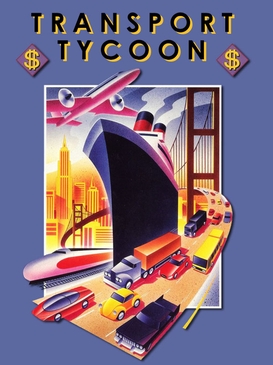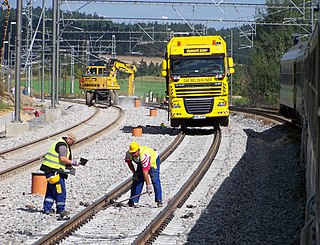A bidirectional text contains two text directionalities, right-to-left (RTL) and left-to-right (LTR). It generally involves text containing different types of alphabets, but may also refer to boustrophedon, which is changing text direction in each row.

A directional antenna or beam antenna is an antenna which radiates or receives greater power in specific directions allowing increased performance and reduced interference from unwanted sources. Directional antennas provide increased performance over dipole antennas—or omnidirectional antennas in general—when greater concentration of radiation in a certain direction is desired.

Transport Tycoon is a video game designed and programmed by Chris Sawyer, and published by MicroProse in 1994. It is a business simulation game, presented in an isometric view in 2D with graphics by Simon Foster, in which the player acts as an entrepreneur in control of a transport company, and can compete against rival companies to make as much profit as possible by transporting passengers and various goods by road, rail, sea and air.

IEEE 1284 is a standard that defines bi-directional parallel communications between computers and other devices. It was originally developed in the 1970s by Centronics, and was widely known as the Centronics port, both before and after its IEEE standardization.
Electronic counter-countermeasures (ECCM) is a part of electronic warfare which includes a variety of practices which attempt to reduce or eliminate the effect of electronic countermeasures (ECM) on electronic sensors aboard vehicles, ships and aircraft and weapons such as missiles. ECCM is also known as electronic protective measures (EPM), chiefly in Europe. In practice, EPM often means resistance to jamming.

A double-track railway usually involves running one track in each direction, compared to a single-track railway where trains in both directions share the same track.
A duplex communication system is a point-to-point system composed of two or more connected parties or devices that can communicate with one another in both directions. Duplex systems are employed in many communications networks, either to allow for simultaneous communication in both directions between two connected parties or to provide a reverse path for the monitoring and remote adjustment of equipment in the field. There are two types of duplex communication systems: full-duplex (FDX) and half-duplex (HDX).

Catch points and trap points are types of turnout which act as railway safety devices. Both work by guiding railway carriages and trucks from a dangerous route onto a separate, safer track. Catch points are used to derail vehicles which are out of control on steep slopes. Trap points are used to protect main railway lines from unauthorised vehicles moving onto them from sidings or branch lines. Either of these track arrangements may lead the vehicles into a sand drag or safety siding, track arrangements which are used to safely stop them after they have left the main tracks.
Bidirectional search is a graph search algorithm that finds a shortest path from an initial vertex to a goal vertex in a directed graph. It runs two simultaneous searches: one forward from the initial state, and one backward from the goal, stopping when the two meet. The reason for this approach is that in many cases it is faster: for instance, in a simplified model of search problem complexity in which both searches expand a tree with branching factor b, and the distance from start to goal is d, each of the two searches has complexity O(bd/2), and the sum of these two search times is much less than the O(bd) complexity that would result from a single search from the beginning to the goal.
Transmitter hunting, is an activity wherein participants use radio direction finding techniques to locate one or more radio transmitters hidden within a designated search area. This activity is most popular among amateur radio enthusiasts, and one organized sport variation is known as amateur radio direction finding.

On a railway, single-line working refers to the practice where, when one line out of the two lines is blocked, trains are able to use the other in either direction. This is usually when a line is out of use for maintenance, or because of damage, obstruction or train failure.

Radio is the technology of signaling and communicating using radio waves. Radio waves are electromagnetic waves of frequency between 30 hertz (Hz) and 300 gigahertz (GHz). They are generated by an electronic device called a transmitter connected to an antenna which radiates the waves, and received by another antenna connected to a radio receiver. Radio is very widely used in modern technology, in radio communication, radar, radio navigation, remote control, remote sensing, and other applications.
Bidirectional associative memory (BAM) is a type of recurrent neural network. BAM was introduced by Bart Kosko in 1988. There are two types of associative memory, auto-associative and hetero-associative. BAM is hetero-associative, meaning given a pattern it can return another pattern which is potentially of a different size. It is similar to the Hopfield network in that they are both forms of associative memory. However, Hopfield nets return patterns of the same size.
The road signs in Poland follow the Vienna Convention on Road Signs and Signals and, therefore, are more or less identical to those in other European countries. Warning signs have yellow background rather than the more common black-on-white design, and therefore similar to the road signs in Greece.

In transportation infrastructure, a bidirectional traffic system divides travellers into two streams of traffic that flow in opposite directions.

The application of railway signals on a rail layout is determined by various factors, principally the location of points of potential conflict, as well as the speed and frequency of trains and the movements they require to make.
Bidirectional recurrent neural networks (BRNN) connect two hidden layers of opposite directions to the same output. With this form of generative deep learning, the output layer can get information from past (backwards) and future (forward) states simultaneously. Invented in 1997 by Schuster and Paliwal, BRNNs were introduced to increase the amount of input information available to the network. For example, multilayer perceptron (MLPs) and time delay neural network (TDNNs) have limitations on the input data flexibility, as they require their input data to be fixed. Standard recurrent neural network (RNNs) also have restrictions as the future input information cannot be reached from the current state. On the contrary, BRNNs do not require their input data to be fixed. Moreover, their future input information is reachable from the current state.
In digital electronics, a level shifter, also called logic-level shifter or voltage level translator, is a circuit used to translate signals from one logic level or voltage domain to another, allowing compatibility between integrated circuits with different voltage requirements, such as TTL and CMOS. Modern systems use level shifters to bridge domains between processors, logic, sensors, and other circuits. In recent years, the three most common logic levels have been 1.8V, 3.3V, and 5V, though levels above and below these voltages are also used.








